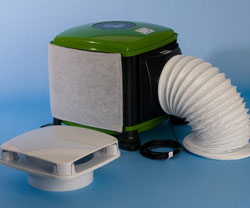Loft Ventilation and Condensation
If a loft doesn’t have proper ventilation, it can cause condensation to gather. There are two main reasons this is an issue. First, condensation can cause wood to begin warping. If this problem continues to be ignored, it can eventually result in structural damage. Second, condensation can lead to mold growth. Once mold begins growing, it can spread very rapidly. Mold can create health problems and also cause structural damage. Additionally, it’s very difficult to permanently remove mold once it starts growing. The good news is while condensation can cause major problems, ensuring a loft is properly ventilated can make it possible for you to avoid those problems.
What Causes Problems with Loft Ventilation?
Insulation that was installed right below a roof’s sheathing is one of the most common causes of poor loft ventilation. The problem with this type of insulation is it can prevent excess heat from escaping. If this occurs, it will result in condensation. This in turn can cause damage throughout a loft’s area. Another common ventilation issue occurs in loft spaces that feature cathedral ceilings. When this type of ceiling doesn’t have any vents located in the soffit, the amount of condensation that builds up can cause the surrounding wood to begin rotting in a fairly short amount of time.
What Types of Vents Can Be Used for Loft Ventilation?
The types of vents that can be used for loft ventilation include:
- Spot vents
- Gable vents
- Ridge vents
- Soffit vents
Spot vents are used for complicated loft designs that can’t be properly ventilated with any other options. Keep in mind that if this ends up being the type of vent that is best for your loft, you will need to provide an outdoor source of air if you want to avoid ending up with higher energy costs. One of the popular features of gable vents is that they have a traditional design. This makes it possible to get the ventilation you want without taking away from the look of your home. While there are uses for ridge vents, most building professionals recommend not using them as the only form of ventilation in your loft. Instead, they can be used in conjunction with soffit vents for the best results.
Useful Loft Ventilation Tips
Because the design of many lofts makes ventilating the area somewhat difficult to do, it’s worth noting that proper balance can play a significant role in achieving your goal. The reason that it’s useful to focus on balancing ventilation between low and high points is because this will allow you to benefit from the convection that will be created. Keeping your ventilation plan balanced will allow you to avoid all of the problems that condensation can cause. Another tip to remember is that if you’re using both soffit and ridge vents, you will want to make sure that the area of the former is larger than that of the latter. By keeping these points in mind, you will be able to properly ventilate the space in your loft.

Categories
- Home
- Loft Ventilation Information
- DIY Loft Ventilation
- Loft Insulation and Ventilation
- Loft Ventilating Roof Space
- Loft Ventilation and Condensation
- Loft Ventilation Building Regulations
- Loft Ventilation Costs
- Loft Ventilation Ideas
- Loft Ventilation Installation
- Loft Ventilation Plans
- Loft Ventilation Problems
- Loft Ventilation Tips
- Loft Ventilation Companies
- Loft Ventilation Products
- Types Of Loft Ventilation
